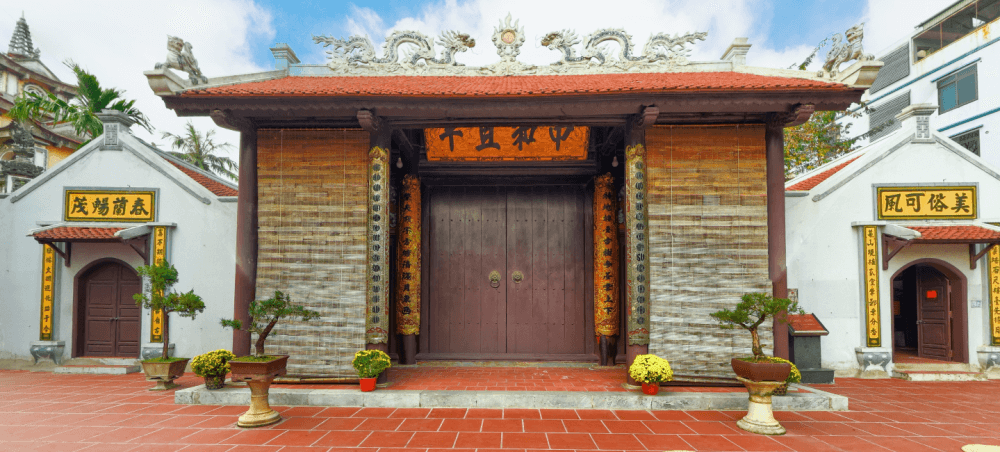

Introduce
Phu Thuong is an ancient land of the city, and has long been associated with Thang Long - Hanoi. Over the thousands of years of history, the people who have worked hard to build the village of the homeland create a cultural tradition of resisting fighting against foreign aggressors protecting the country.
Located in the northwest, about ten miles from the center of Thang Long, there is an ancient village called Phu Gia, known as Ga village. In the Nguyen Dynasty, Phu Gia belonged to Phu Gia, Tu Liem district, Hoai Duc, Ha Dong province. Today, according to the administrative boundaries, the village is located in Phu Thuong ward, which is joined by three ancient villages of Phu Gia (Ga village) in the middle, Thuong Thuy (Bac village) in the west and Phu Xa (Xu village) in the east.
Phu Thuong became a safe area for the Party Central Committee, hiding and protecting many of the Party's top leaders and the first place to welcome President Ho Chi Minh from the Viet Bac area returned to the capital. Over the years, the Phu Thuong people have built a village homeland to create this land as an ancient cultural area. Up to this day, the ancient communal houses and pagodas, such as Phu Gia communal house, Ba Gia pagoda, Thuong Thuy communal house, Phu Xa pagoda and communal house ... still have their own traditional cultural identity.
Phu Gia communal house is located in the center of the village adjacent to National Highway 23 (now known as An Duong Vuong Street), about 9 km North West of Hanoi. To go to the monument, visitors can follow the route: From the city center (Bo Ho post office) follow the streets Le Lai - Tran Quang Khai - Tran Nhat Duat - Yen Phu - Nghi Tam - Au Co and stop at alley 209 An Duong Vuong street to Phu Gia communal house.
Phu Gia communal house worshiped the general in the reign of the 6th Hung Vuong who had many great achievements in fighting the invaders to save the country and was considered as the village god. According to the legend and folk tales still preserved in Phu Gia communal house, the deity of the house can be summarized as follows:
The god named Nhu or also known as "Than Gia La" (also the name of the river later changed to Thien Phu) is called the Khai Nguyen god. In the reign of Hung Vuong, he took his troops to fight the enemy, and was attacked by the enemy and the head fell to one side but still riding back to the front of the village, next to Hong garden, where the big tree next to the water shop, he asked. "If my neck is like this, can I still survive?" “You have to come from heaven to continue living like that.” said the woman in the water shop. Then he rode a short distance to the head of the village then stopped breathing, after he passed away the villagers of Phu Gia built Phu Gia communal house to remember his merits; The story has been circulated locally until today.
Every year, the villagers bring his tablet from the communal house to the tree to do the ceremony of worshiping, the later dynasties also confer him as gods.
According to the legend of Phu Gia village and some other books written: The mandarin of the Tang dynasty Lu Anh came to our country and set up camps in An Vien village, between Long Do and Tu Liem districts. One day, he went out and saw that this land is flat, trees are good, there is the Giang River nearby, and beautiful terrain. Lu Anh decided to set up the residence and a temple to worship Huyen Thien De Quan. One night, Lu Anh dreamed that a bearded old man told him: "This place should set up a tablet and name Khai Nguyen to commend the merits of the gods." When Lu Anh woke up, he put the name of the village and the temple as Khai Nguyen, and set up stele to indicate the merits of King Khai Nguyen - Tang Dynasty. Throughout the reign, the communal house is very sacredly called the Gia La Quan or also known as the Gia La god.
Gia La is the name of the land, an ancient river name. Gia La god was also associated with the national hero who followed Phu Dong Thien Vuong to fight the enemy and then sacrificed. The gods have fought the invaders to help the country, help the people after natural disasters to bring a happy life for all people.
According to the legend: "ban xa than ky" is still kept in the communal house, he is an Earth god.
"... At that time, the dyke was flooded, the life of the people was at risk, then the spirit of the God warned that: "I will save people and the country.” The flood of water was too intense, then a mandarin followed the king’s order to set up an altar for the god. Then in the next morning there was a large wooden tree drifting up to suppress the water from above to stop the flood. At that time, the king built a temple for worshiping the god and also changed the name of the place to Phu Gia ward to allow people to worship forever. "
Later, the dynasty conferred the god as "The supreme god", engraving tablets to worship.
At the beginning of the Nguyen dynasty, the Red River was flooded with people who left their homes. After returning to the pure custom, he began rebuilding to remember the merits of god. People relied on the old convention and the god’s legend to reconstruct Phu Gia communal house. Later the king dynasties issued the royal edict: "The god is the great and his merit is as deep as the sea, touching people, following heaven’s will help people to be happy forever."
Every year to commemorate the merits of the god, the villagers took January 10 (lunar calendar) as the village festival to pay respect and thank the gods for the rain and wind, the villagers live in peace and happiness.
Previously, the communal house has small-scale, simple three-room but later on has been paid attention to by the people of Tay Ho district, Phu Thuong ward and Nam Thang Long limited company to invest billions of vnd to renovate the communal house so Phu Gia communal house is now quite dignified.
The house was built on relatively spacious land (on the same floor of the old communal house) in the center of Phu Gia village and turned south, surrounded by a wall, covering an area of nearly 2000 m2. The front is the system of ancient trees creating a cool, dignified space for the ancient house.
In the end is the square pond (shaped like a seal), the area of about 300m2, the summer is released, lotus flowers scented aroma create space for beautiful fresh air for the communal house.
Nghi gate (or Nghe gate): It is a three-dimensional house made of wood that is quite unique, roof covered with tile and the top of the roof is curved. The upper part of the strip is also about 30cm high, the head is curved to the long brick yard leading to the altar area, the yard is divided into several levels, along the two sides of the yard are two rows of ancient trees.
The main architecture of the Phu Gia communal house includes: Main temple and the harem. The main temple consists of 5 new chambers renovated by the government and the people in recent times (the occasion of the 1000th anniversary of Thang Long - Hanoi) by woods and the roof covered with tile. The front door is a wooden door system. Phu Gia main temple was built on a high platform with 5 steps from the yard. All the structure of the communal house after the restoration of embellishment, the framework of the Nghi gate main temple, front house and the harem and the two sides of the spear, are all made of iron wood. There are 4 sets of trusses which are about 60 cm above the surface. The main temple is made in the form of a retaining wall, the roof runs directly between the dragon and the sun. Dragons are simple and tails. The two sides reconstructed the wall connecting two small ports to the back.
There are 3 rooms in the harem. Brick floor, the frame is made simple and in front is a wooden door system. The central throne is in the center of the altar, the tablet of the god and the statue of him.
Phu Gia communal house also retains a rich system of relics rich in various types and materials such as the system of gods, bronze bell, throne, wood palanquin, horizontal lacquered, parallel sentences, dragon throne, cultural values, science and aesthetics with 16 original edict dating back to the Le - Nguyen period. The earliest date is Thinh Duc Le Than Tong dated 06/07/1655. The communal house also preserves the Mac masterpiece of gold lacquered wood, no other place has. These relics are a valuable source of valuable documents that contribute to the understanding of the history of the gods in the Vietnamese spiritual system and the development of Vietnamese communal houses throughout the ages with different historical periods of the country.
Phu Gia communal house is home to many valuable historical, cultural and artistic objects that enable researchers to determine the authentic value of the relics that summarize the precise meaning of the past. Including: 02 god scroll in Chinese characters about the merits of the god; 16 original edicts, including 08 from Le, 01 from Tay Son and 03 from Nguyen dynasty, in addition to many valuable objects.
From the past till now, the communal house has been the center of traditional cultural activities of the locals, where the moral education of “drinking water remembers the source”. The image of the communal house became familiar with the spiritual life of the people. The communal house is also a worshiping place for the gods who have merit with the people and the place where the elderly people meet in the village to discuss the activities of the village and the place where the annual festival takes place.
With all the above mentioned tangible and intangible cultural values, Phu Gia communal house has made great contributions to studying the development of the communal house in Viet Nam, so the Phu Gia communal house was granted the Ministry of Culture This information is the Ministry of Culture, Sports and Tourism recognized as national historical and cultural relics in Decision No. 53/2001 / QD / VHTT dated 28/12/2001.
Artifacts
Map
Nearby Places
No. 43C, alley 497, quarter 2, group 15, Lac Long Quan Street, Nhat Tan Ward
2.68Km
No.6, Lane 319, An Duong Vuong Street, Phu Thuong ward
0.18Km
Lane 242, Lac Long Quan Street, Buoi Ward, Tay Ho District, Hanoi.
No. 20, Lane 472, Cluster 3, Lac Long Quan Road, Nhat Tan Ward, Tay Ho District, Hanoi.
No. 35, Lane 416, Lac Long Quan Road, Nhat Tan Ward, Tay Ho District, Hanoi.
0.83Km
No. 07, Lane 30, Tay Ho Road, Quang An Ward, Tay Ho District, Hanoi.
3.15Km
Residential Area No. 5 (No. 3, Lane 200, Au Co Road), Tu Lien Ward, Tay Ho District, Hanoi.
3.63Km
Residential Area No. 5 (No. 3, Lane 200, Au Co Road), Tu Lien Ward, Tay Ho District.
3.26Km